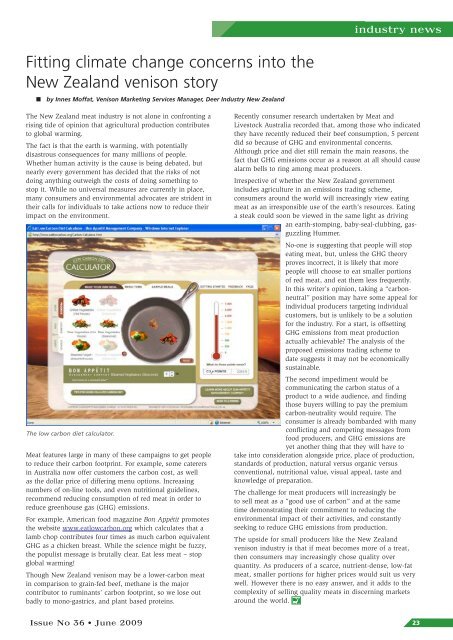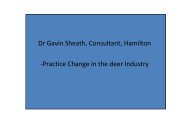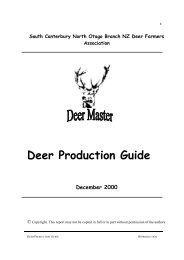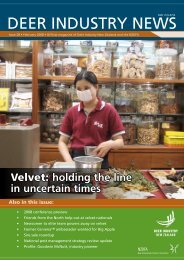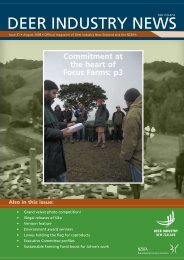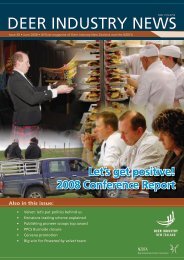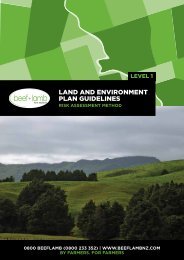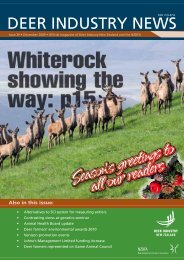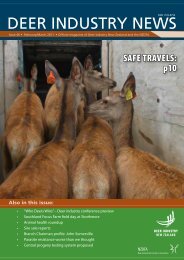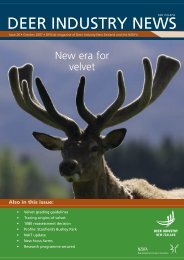Deer Industry News #36 June 2009 - Deer Industry New Zealand
Deer Industry News #36 June 2009 - Deer Industry New Zealand
Deer Industry News #36 June 2009 - Deer Industry New Zealand
- No tags were found...
You also want an ePaper? Increase the reach of your titles
YUMPU automatically turns print PDFs into web optimized ePapers that Google loves.
industry newsFitting climate change concerns into the<strong>New</strong> <strong>Zealand</strong> venison story■■by Innes Moffat, Venison Marketing Services Manager, <strong>Deer</strong> <strong>Industry</strong> <strong>New</strong> <strong>Zealand</strong>The <strong>New</strong> <strong>Zealand</strong> meat industry is not alone in confronting arising tide of opinion that agricultural production contributesto global warming.The fact is that the earth is warming, with potentiallydisastrous consequences for many millions of people.Whether human activity is the cause is being debated, butnearly every government has decided that the risks of notdoing anything outweigh the costs of doing something tostop it. While no universal measures are currently in place,many consumers and environmental advocates are strident intheir calls for individuals to take actions now to reduce theirimpact on the environment.The low carbon diet calculator.Meat features large in many of these campaigns to get peopleto reduce their carbon footprint. For example, some caterersin Australia now offer customers the carbon cost, as wellas the dollar price of differing menu options. Increasingnumbers of on-line tools, and even nutritional guidelines,recommend reducing consumption of red meat in order toreduce greenhouse gas (GHG) emissions.For example, American food magazine Bon Appétit promotesthe website www.eatlowcarbon.org which calculates that alamb chop contributes four times as much carbon equivalentGHG as a chicken breast. While the science might be fuzzy,the populist message is brutally clear. Eat less meat – stopglobal warming!Though <strong>New</strong> <strong>Zealand</strong> venison may be a lower-carbon meatin comparison to grain-fed beef, methane is the majorcontributor to ruminants’ carbon footprint, so we lose outbadly to mono-gastrics, and plant based proteins.Recently consumer research undertaken by Meat andLivestock Australia recorded that, among those who indicatedthey have recently reduced their beef consumption, 5 percentdid so because of GHG and environmental concerns.Although price and diet still remain the main reasons, thefact that GHG emissions occur as a reason at all should causealarm bells to ring among meat producers.Irrespective of whether the <strong>New</strong> <strong>Zealand</strong> governmentincludes agriculture in an emissions trading scheme,consumers around the world will increasingly view eatingmeat as an irresponsible use of the earth’s resources. Eatinga steak could soon be viewed in the same light as drivingan earth-stomping, baby-seal-clubbing, gasguzzlingHummer.No-one is suggesting that people will stopeating meat, but, unless the GHG theoryproves incorrect, it is likely that morepeople will choose to eat smaller portionsof red meat, and eat them less frequently.In this writer’s opinion, taking a “carbonneutral”position may have some appeal forindividual producers targeting individualcustomers, but is unlikely to be a solutionfor the industry. For a start, is offsettingGHG emissions from meat productionactually achievable? The analysis of theproposed emissions trading scheme todate suggests it may not be economicallysustainable.The second impediment would becommunicating the carbon status of aproduct to a wide audience, and findingthose buyers willing to pay the premiumcarbon-neutrality would require. Theconsumer is already bombarded with manyconflicting and competing messages fromfood producers, and GHG emissions areyet another thing that they will have totake into consideration alongside price, place of production,standards of production, natural versus organic versusconventional, nutritional value, visual appeal, taste andknowledge of preparation.The challenge for meat producers will increasingly beto sell meat as a “good use of carbon” and at the sametime demonstrating their commitment to reducing theenvironmental impact of their activities, and constantlyseeking to reduce GHG emissions from production.The upside for small producers like the <strong>New</strong> <strong>Zealand</strong>venison industry is that if meat becomes more of a treat,then consumers may increasingly chose quality overquantity. As producers of a scarce, nutrient-dense, low-fatmeat, smaller portions for higher prices would suit us verywell. However there is no easy answer, and it adds to thecomplexity of selling quality meats in discerning marketsaround the world.Issue No 36 • <strong>June</strong> <strong>2009</strong> 23


